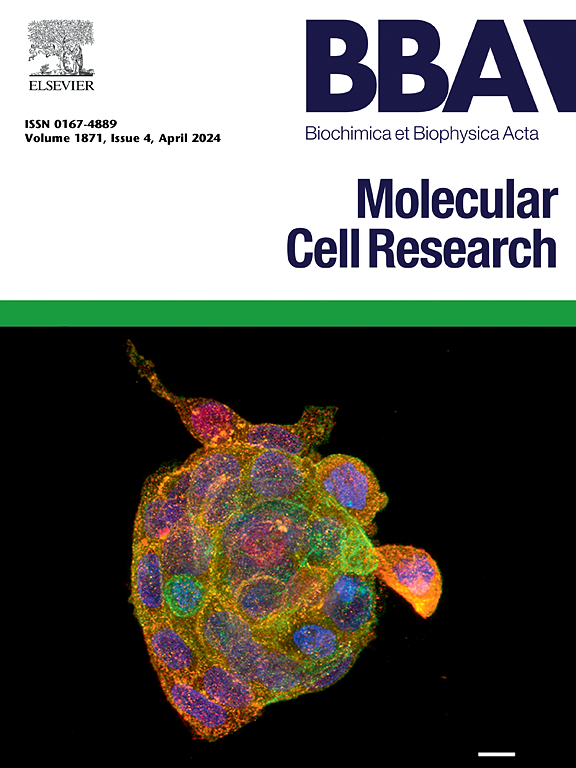Hypoxia enhances IL-8 signaling through inhibiting miR-128-3p expression in glioblastomas
IF 4.6
2区 生物学
Q1 BIOCHEMISTRY & MOLECULAR BIOLOGY
Biochimica et biophysica acta. Molecular cell research
Pub Date : 2025-02-01
DOI:10.1016/j.bbamcr.2024.119885
引用次数: 0
Abstract
Glioblastoma multiforme (GBM) is an aggressive type of brain tumor known for its hypoxic microenvironment. Understanding the dysregulated mechanisms in hypoxic GBM is crucial for its effective treatment. Through data mining of The Cancer Genome Atlas (TCGA) with hypoxia enrichment scores and in vitro experiments, miR-128-3p was negatively correlated with hypoxia signaling and the epithelial-mesenchymal transition (EMT). Additionally, lower miR-128-3p levels existed in hypoxic GBM, leading to desensitizing temozolomide (TMZ)'s efficacy, a first-line therapeutic drug for GBM. Overexpressing miR-128-3p enhanced both the in vitro and in vivo sensitivity of hypoxic gliomas to TMZ treatment. Mechanistically, HIF-1α suppressed miR-128-3p expression in hypoxic GBM. Through establishing miR-128-3p-mediated transcriptomic profiles and data mining, interleukin (IL)-8 was selected. IL-8 respectively showed positive and negative correlations with hypoxia and miR-128-3p, and was associated with poor TMZ therapeutic results in GBM. Elevated miR-128-3p, which targets both the 3′-untranslated region (UTR) and 5′UTR of IL-8, resulted in suppression of IL-8 expression. Moreover, IL-8 was validated to be involved in HIF-1α/miR-128-3p-regulated TMZ sensitivity and the EMT in hypoxic GBM cells. Collectively, the HIF-1α/miR-128-3p/IL-8 signaling pathway plays a critical role in promoting the progression of hypoxic GBM. Targeting this signaling pathway holds promise as a potential therapeutic strategy.

缺氧通过抑制miR-128-3p在胶质母细胞瘤中的表达来增强IL-8信号。
多形性胶质母细胞瘤(GBM)是一种侵袭性脑肿瘤,以其缺氧微环境而闻名。了解缺氧GBM的失调机制对其有效治疗至关重要。通过对癌症基因组图谱(TCGA)的数据挖掘和缺氧富集评分以及体外实验,miR-128-3p与缺氧信号传导和上皮-间质转化(EMT)呈负相关。此外,低氧GBM中存在较低的miR-128-3p水平,导致替莫唑胺(TMZ)的疗效脱敏,这是GBM的一线治疗药物。过表达miR-128-3p增强了缺氧胶质瘤对TMZ治疗的体外和体内敏感性。在机制上,HIF-1α抑制miR-128-3p在缺氧GBM中的表达。通过建立mir -128-3p介导的转录组谱和数据挖掘,选择白细胞介素(IL)-8。IL-8分别与缺氧和miR-128-3p呈正相关和负相关,并与TMZ治疗GBM效果差有关。miR-128-3p同时靶向IL-8的3'-非翻译区(UTR)和5'UTR,升高导致IL-8表达抑制。此外,IL-8被证实参与了缺氧GBM细胞中HIF-1α/ mir -128-3p调节的TMZ敏感性和EMT。总之,HIF-1α/miR-128-3p/IL-8信号通路在促进缺氧GBM的进展中起关键作用。靶向这一信号通路有望成为一种潜在的治疗策略。
本文章由计算机程序翻译,如有差异,请以英文原文为准。
求助全文
约1分钟内获得全文
求助全文
来源期刊
CiteScore
10.00
自引率
2.00%
发文量
151
审稿时长
44 days
期刊介绍:
BBA Molecular Cell Research focuses on understanding the mechanisms of cellular processes at the molecular level. These include aspects of cellular signaling, signal transduction, cell cycle, apoptosis, intracellular trafficking, secretory and endocytic pathways, biogenesis of cell organelles, cytoskeletal structures, cellular interactions, cell/tissue differentiation and cellular enzymology. Also included are studies at the interface between Cell Biology and Biophysics which apply for example novel imaging methods for characterizing cellular processes.

 求助内容:
求助内容: 应助结果提醒方式:
应助结果提醒方式:


